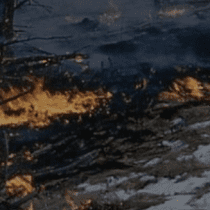Fire Regimes
The most common misconception of wildfire is that all fire is bad. But there are important benefits that smaller and more frequent fires offer to the environment. Matt Jolly, an ecologist at the U.S. Forest Service Rocky Mountain Research Station, talks about the natural and important role of fire in maintaining a healthy ecosystem.
Fire frequency has decreased in many shrub-steppe communities. Re-introducing fire may be needed to increase spatial and temporal variability in vegetation, but is often hindered by concerns of undesired vegetation shifts. These concerns arise, in part, because long-term effects of fire re-introduction in these communities after prolonged fire exclusion and other departures from historical conditions are unknown. To better understand the effects of re-introducing fire, we evaluated plant community response to re-introducing fire for 12 years post fire in six mountain big sagebrush communities. Herbaceous biomass production was 1.7-fold greater in burned compared with unburned areas at the conclusion of the study. Exotic annual grasses appeared to be problematic in the first 8 years post fire, but became inconsequential (~1% cover) by the end of the study. Re-introducing fire promoted other shrubs (excluding sagebrush) that were probably inhibited by competition from sagebrush. Sagebrush cover and density remained low in burned areas for the duration of the study, because of limited recruitment in the years immediately post fire and competition from herbaceous vegetation. Re-introducing fire appears to increase temporal and spatial heterogeneity in shrub-steppe communities experiencing prolonged fire exclusion and, therefore, may be needed to maintain a diversity of plant communities.
In the Western U.S., the 2020 fire season is setting new records in terms of geographic scale, fire intensity, and rates of spread. Tens of millions of people are currently being forced to breathe beneath a dense layer of smoke, as others have lost their lives and property.
With each new record-setting fire, the same question comes up again and again: is this due to climate change, or is this due to forest mismanagement? After dueling appearances on Monday, this question now appears to be a matter of debate in the Presidential campaign.
The climate change vs. management question ignores nuance that is crucial for finding scientific answers and policy solutions. The factors influencing wildfire behavior are complex, and the dominant drivers vary between different locations and events. Below are five key things to know about the causes of the current wildfire problem. Understanding them can help us navigate the question of what is driving increased fire activity and what can be done to reduce such large fires in the future.
Webinar recording.
Description: Range of Variability (ROV) concepts – including Natural (NRV), Historic (HRV), Current (CRV), and Future (FRV) – are frequently used by the US Forest Service to help define land management goals. This webinar provides an introduction to ROV terminology and examples of how the Malheur, Umatilla, and Wallowa-Whitman National Forests in the Blue Mountains have applied ROV concepts during project planning when addressing key requirements of the Eastside Screens. The discussion includes overviews of tools commonly used to conduct ROV analyses.
Presenter: Nathan Poage, Forest Service Ecologist,
Access report.
Wildfire across the western US has increased in size, frequency, and severity since the 1950s. These changes are closely linked with increases in temperature and an increased frequency and intensity of drought. Historically, frequent low to moderate-severity fires dominated the fire regime in many western forests, maintaining low-density forests with larger trees. A history of fire exclusion, logging activity, grazing, and invasive species has led to an uncharacteristic build-up of forest fuels in many areas, increasing the susceptibility to large-scale, high-severity wildfire. The US has a history of fire suppression efforts that has exacerbated the problem by increasing the density of trees and fuel availability, and reduced the overall area burned by wildfires to levels that are below those that occurred before the beginning of the 20th century.
The western US is also experiencing larger, more severe fires that are often near communities. In recent decades, the build-up of forest fuels, a warmer and drier climate, and expansion of the wildland-urban interface (WUI) into forested areas has changed western landscapes and increased wildfire hazard. Federal policy and management have primarily focused on fire suppression and more recently on fuels reduction on some federal lands. Forest restoration and fuels reduction projects have had positive ecological impacts; however, the pace and scale of forest treatments is not keeping up with heightened wildfire activity across the West.
The Northeastern California Plateaus Bioregion Science Synthesis reviews literature relevant to the ecology and management of the Great Basin ecosystems and dry pine forests of the Lassen and Modoc National Forests. Critical factors on these national forests are reduced water availability—expected to become more challenging as levels and patterns of precipitation and temperature change under climate variability—coupled with a high proportion of rangeland and open woodland whose vegetation community is influenced by grazing of livestock and wild animal populations. Conifer encroachment of rangelands and the densification of woodlands, a result of fire suppression, impact wildlife communities that rely on open woodlands and other habitats characterized by having overstories of low density. Sagebrush habitat, in particular, is threatened by fragmentation and conversion. Socioeconomic changes in the region include a transition in the economic base from extraction to that of consumption of amenity values, and the resulting fragmentation of landownership. The local human population is expected to continue its trend of decline, but increased pressure by recreationists from nearby expanding urban areas is forcing land managers to consider increasingly complex situations or actions integrating social, ecological, and economic factors. Indigenous peoples are assuming a greater role in the management of their lands. Finally, disturbance patterns, such as nonhistorical fire frequency and intensity levels, novel combinations of climate patterns, and the pervasive pressure of nonnative invasive species could result in future ecosystems different than those today, presenting additional managerial challenges. This synthesis is intended to serve as a science-based foundation that supports management of Northeastern California forests, woodlands, and rangelands.
Access brief and full article.
This California Fire Regime Ecoregion classification map (i.e., using clustered driver variability layers) aims to devise a fire regime classification that better aligns with ecosystem types.
Overview: Invasive annual grasses are quickly expanding across the West, dramatically changing sagebrush country. Today we are experiencing more frequent and hotter wildfires that are harmful to communities, western lands, and wildlife. This webinar discusses the wildfire trends, identify the culprits, the impacts, and break down the challenges/opportunities.
Presenter: Michele Crist, leading landscape ecologist with the National Interagency Fire Center.
Resources and information referenced in the webinar available on the SageWest website.
Cheatgrass Challenge webpage.
The Bureau of Land Management (BLM) and Natural Resources Conservation Service (NRCS) in Idaho and Wyoming have teamed up with each other along with partners in their respective states to address cheatgrass proliferation in the West. The Cheatgrass Challenge is a call to arms for agricultural producers, federal and state agencies, educational institutions and non-profit organizations.
As the Challenge develops, the webpage will be updated with additional information and resources, so check back regularly for updates.
Access the synthesis.
In this report, we identify and characterize scientific literature produced by USGS scientists during 2006–17 that addresses topics associated with wildland fire science. Our goals were to (1) make the most complete list possible of product citations readily available in an organized format, and (2) use bibliometric analysis approaches to highlight the productivity of USGS scientists and the impact of contributions that the Bureau has provided to the scientific, land management, and fire management communities.







